-
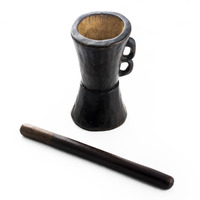 Mortar and pestle
Mortar and pestle As president of Liberia, Ellen Johnson Sirleaf has worked to promote peace, reconciliation and social and economic development. This mortar and pestle was given to her by rural women farmers as a gift.
Ellen Johnson Sirleaf donated the mortar to the Nobel Prize Museum in 2011.
-
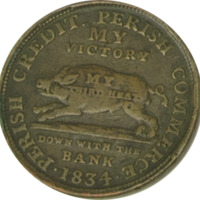 Hard-times token
Hard-times token This token was given to Thomas Sargent by his grandfather and was the key object that sparked his interest in economics. Hard-times tokens were privately issued, unofficial currency. They were issued in the U.S. during the financial and political turmoil of 1833-1843. Hard-times tokens often had a satirical political content. This particular token, issued in 1834, is advocating against President Andrew Jackson. Sargent has subsequently published papers on the history and development of economics in the U.S.
Thomas Sargent donated the token to the Nobel Prize Museum in 2011.
-
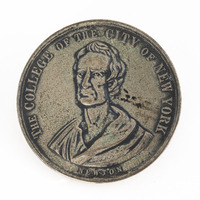 Medal
Medal This medal, the Belden Mathematical Prize, was awarded to Moses Greenfield in 1935, on the occasion of being the second best mathematics student in the New York City public schools. Greenfield is Thomas Sargent’s father-in-law and gave him this medal after they co-authored a research paper in 1993.
Thomas Sargent donated the medal to the Nobel Prize Museum in 2011.
-
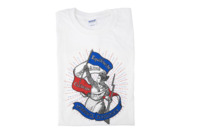 T-shirt
T-shirt This T-shirt is from the Minnesota Economics Department at the University of Minnesota, where Thomas Sargent worked in the 1970s and 1980s. The image is a paraphrase of Eugène Delacroix’s painting "Liberty Leading the People", which celebrates the July Revolution in France in 1830. Instead of the national motto of France, “Liberté, Égalité, Fraternité” (“Liberté, égalité, fraternité”) it says “Equilîbrité, Optimâlité, Calîbrité”, which is faux-french for “Equilbrium, Optimality, Calibration” – key concepts in econometrics.
Thomas Sargent donated the T-shirt to the Nobel Prize Museum in 2011.
-
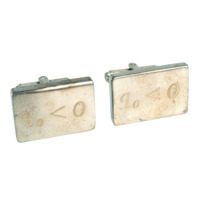 Cufflinks
Cufflinks In the lead-up to the Nobel Prize award ceremony 2011, physics laureate Adam Riess had cufflinks made for himself and the 18 members of his research team.
The cufflinks have a formula, “q0<0”, engraved on them. The meaning of the formula is that our universe is expanding at an ever-increasing rate. This was the discovery that Riess and his co-laureates were awarded the physics prize for.
Riess commissioned the cufflinks seen here before ordering a pair for each researcher. He donated the prototypes to the Nobel Prize Museum 2011.
-
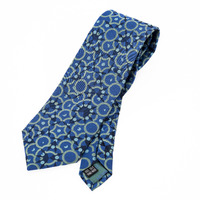 Tie
Tie The pattern on this tie is a quasicrystal, a structure that is ordered but not periodic. Physicists had long agreed that all crystal structures followed a periodic pattern, and , Dan Shechtman met with scepticism in 1982, when he showed that quasicrystals existed. It eventually turned out that he was right, and he was awarded the 2011 Nobel Prize in Chemistry for this discovery. Shechtman received the tie for his 70th birthday from the Technion – Israel Institute of Technology in Haifa, whose vice-chancellor Peretz Lavie had had it custom-made.
Dan Shechtman donated the tie to the Nobel Prize Museum in 2011.
-
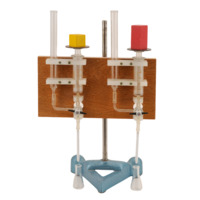 Apparatus
Apparatus Arvid Carlsson and his colleagues designed this device for cleaning tissue extract and isolating dopamine and other substances. Cleaning takes place by pressing the extract through an ion exchange column thatcan take up and bind the dopamine. Thereafter, a liquid is pressed through the column. The liquid releases the dopamine and separates other components. This enables a subsequent determination of the amount of dopamine.
Arvid Carlsson donated the apparatus to the Nobel Prize Museum in 2011.
-
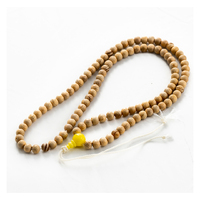 Rosary
Rosary This rosary, a japa mala, is an eastern rosary with 108 beads, used in both Buddhism and Hinduism for counting mantras.
The 14th Dalai Lama donated the rosary to the Nobel Prize Museum in 2011.
-
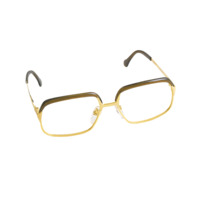 Glasses
Glasses One of the first things you notice about Tenzin Gyatso, the Fourteenth Dalai Lama of Tibet, is his glasses. Does the Dalai Lama see the world differently than we do? For the Dalai Lama, the cultivation of inner peace and integrity is the ultimate means of achieving positive change in an irrational world. Tolerance and understanding are the key components in his world view.
The Dalai Lama donated the glasses to the Nobel Prize Museum in 2011.
-
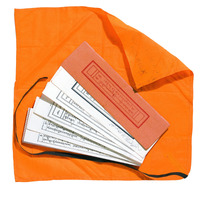 Sutra
Sutra Even today’s world, the Dalai Lama finds wisdom and inspiration in a sutra with old Buddhist texts.
For the Dalai Lama, the cultivation of inner peace and integrity is the ultimate means of achieving positive change in an irrational world. In his Nobel Prize lecture, he said, “Inner peace is the key: if you have inner peace, the external problems do not affect your deep sense of peace and tranquility. In that state of mind, you can deal with situations with calmness and reason, while keeping your inner happiness.”
The 14th Dalai Lama donated the sutra to the Nobel Prize Museum in 2001.
-
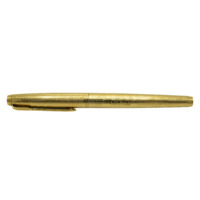 Fountain pen
Fountain pen Pennan har tillhört den 14:e Dalai Lama.
Dalai lama donerade pennan till Nobelprismuseet 2011.
-
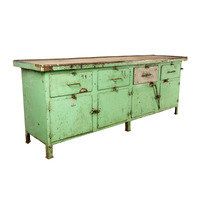 Workbench
Workbench This workbench is from the workshop at the former Lenin Shipyard in Gdansk, where Lech Wałęsa worked as an electrician. The independent trade union Solidarity was established after a major strike in Poland in 1980. Wałęsa was one of its founders and became its leader and spokesperson.
Solidarity was crucial in developments that eventually led to the fall of the communist regimes in Eastern Europe. Wałęsa was elected president of Poland in 1990. The massive weight of the workbench is a reminder of Wałęsa’s background as a worker but also symbolises the force of the upheavals that he helped instigate.
The bench was donated to the Nobel Prize Museum in 2010 by the shipyard in Gdansk in connection with an art installation by Grzegorz Klaman at the museum.
-
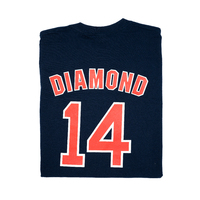 T-shirt
T-shirt T-tröjan utformades av Peter Diamonds doktorander till hans 70-årsdag 2010. Den bär hans namn DIAMOND och heminstitution MIT ECON. Typsnittet är det som används av baseboll-laget Boston Red Sox, som Diamond hängivet hållit på sedan 1949. Som många andra amerikanska pojkar fördjupade han sig i statistik om spelare och matcher, vilket ledde till en hel del huvudräkning. Även senare fick han genom sitt basebollintresse, särskilt genom baseboll-statistikern Bill James analyser, mycket erfarenhet och kunskap om statistiska samband och hur man kan dra slutsatser från tillgänglig information.
I samband med 70-årsdagen ordnade Diamonds fru så att han fick kasta den första pitchen vid en av Boston Red Sox matcher. Många doktorander och lärare vid MIT närvarade iklädda den för Diamond särskilt formgivna tröjan. När Diamond senare samma år utsågs till ekonomipristagare bar många kolleger sina tröjor vid firandet på institutionen.
Peter Diamond donerade tröjan till Nobelprismuseet 2010.
-
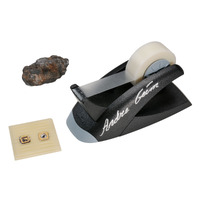 Graphite, tape dispenser and electronic device
Graphite, tape dispenser and electronic device Using ordinary tape and a piece of graphite, Andre Geim and Konstantin Novoselov conducted an experiment with surprising results.
Graphite is a form of carbon that is used in pencils, for example. Physicists had calculated that layers of graphite just one atom thick would have interesting properties, but it was considered impossible to produce in reality. Nevertheless, Geim and Novoselov attempted to separate thin flakes of carbon from a piece of graphite using ordinary tape. Some of these flakes were extremely thin. The new material – “graphene” – had been created.
This device is one of the first where graphene was used.
Andre Geim and Konstantin Novoselov donated the graphite, tape dispenser and electronic device to the Nobel Prize Museum in 2010.
-
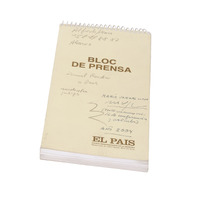 Notepad
Notepad A notepad is often an author’s most important tool. This one originally belonged to Mario Vargas Llosa. It was given to him by El País, Spain’s largest newspaper, to which Vargas Llosa sometimes contributes. Vargas Llosa often takes part in discourse on current issues. He wrote about world events that took place in 2004 in this notepad. Apart from writing, he has also been politically active, running for president in his native Peru in 1990.
Mario Vargas Llosa donated the notepad to the Nobel Prize Museum in 2010.
-
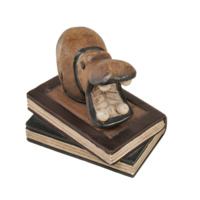 Wooden hippopotamus
Wooden hippopotamus Mario Vargas Llosa has a large collection of hippopotami at home. They even occur in his literary works, as in the play Kathie and the Hippopotamus. Vargas Llosa took a particular liking to a story about a baby hippopotamus that lost its mother when the tsunami hit Kenya in 2004. The baby hippopotamus began searching for a new mother and made an unexpected choice – a 100-year-old tortoise! The tortoise took care of the baby hippo and, when the hippo was fully-grown, it cared for the aged tortoise. Vargas Llosa suggests we should be more like the hippo and the tortoise.
Mario Vargas Llosa donated the hippopotamus to the Nobel Prize Museum in 2010.
-
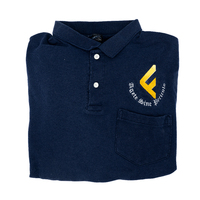 Long Sleeve T-Shirt
Long Sleeve T-Shirt På Oliver Williamsons tröja återfinns ett motto "agete sine periculo", vilket betyder "agera försiktigt".
Oliver Williamson donerade tröjan till Nobelprismuseet 2009.
-
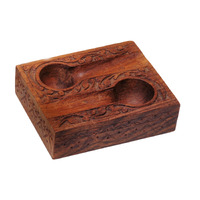 Pipe holder
Pipe holder The pipe holder was Oliver Williamson's companion when he wrote one of his major works, Transaction Cost Economics, during the 1970s.
Oliver Williamson donated the pipe holder to the Nobel Prize Museum in 2009.
-
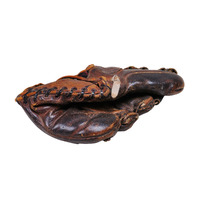 Baseball mitt
Baseball mitt Baseball was a sport dear to Oliver Williamson's heart. The mitt also had a special meaning to him because baseball taught him a lot about the importance of teamwork.
Oliver Williamson donated the baseball mitt to the Nobel Prize Museum in 2009.
-
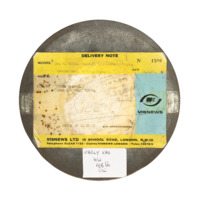 Film reel
Film reel The film, from 1966, shows Charles Kao during his early experiments with optical fibres conducted at the British telecom company Standard Telecommunication Laboratories.
Kao's findings from the experiments were that optical fibres could be used for efficient transfer of information, if only the glass they were made of could be purified. This was eventually made possible, and a large part of our communication today is through optical fibres.
The film was donated to the Nobel Prize Museum by Richard Epworth at Standard Telecommunication Laboratories when Kao was awarded the Nobel Prize in Physics in 2009.
-
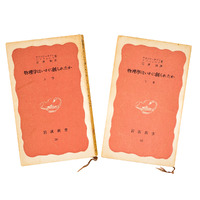 Book by Albert Einstein and Leopold Infeld
Book by Albert Einstein and Leopold Infeld The Evolution of Physics is a popular science book by Albert Einstein and Leopold Infeld. Reading a Japanese edition of it as a high school student it inspired Makato Kobayashi to pursue the study of physics.
Makato Kobayashi donated the books to the Nobel Prize Museum in 2009.
-
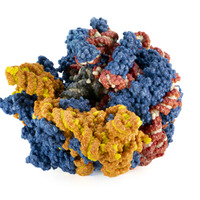 Model of a ribosome
Model of a ribosome This model represents a ribosome. The ribosomes in our cells are where one of the most fundamental processes in the chemistry of life takes place: the production of proteins based on the genetic information in RNA molecules.
The highly complex ribosome structure could be mapped thanks to the efforts of many scientists, including Thomas Steitz, Venkatraman Ramakrishnan and Ada Yonath.
Thomas Steitz donated the model to the Nobel Prize Museum in 2009.
-
 Seed of a Tambalacoque tree
Seed of a Tambalacoque tree Can an authorship be symbolised by a nut? Jean-Marie Gustave Le Clézio picked this nut from one of the few surviving tambalacoque trees on the island of Mauritius. According to legend, the seeds of this tree were once spread via the droppings of the dodo. When the Europeans arrived on the island in the 1600s, all the dodos were gradually killed and the seeds of the tambalacoque tree could no longer germinate. Le Clézio often writes about the encounter of Western and other cultures. He is often critical of the way Europeans have treated peoples in other parts of the world.
Jean Marie Gustave Le Clézio donated the nut and the letter to the Nobel Prize Museum in 2009.
-
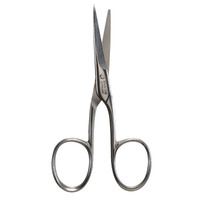 Nail scissors
Nail scissors These scissors suggest an experimental approach to writing poetry. When she is not writing novels, Herta Müller creates poetry in the form of collage. She cuts out words and phrases from printed texts and arranges them in new combinations and images.
The nail scissors were used when she first began creating her collages. When a travelling cutler came to Müller's neighborhood, she left her scissors with him for sharpening. However, when he returned the scissors, one of the blades was crooked. When her husband tried to bend it back into shape, it broke off. In despair, she began searching for a new pair.
Herta Müller donated the scissors to the Nobel Prize Museum in 2009.
-
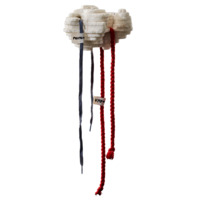 Model of a ribosome
Model of a ribosome The model is a simplified representation of a ribosome – one of many refined and complex structures found in our cells. A ribosome consists of hundreds of thousands of atoms. Mapping all of their positions in detail was generally considered impossible when Ada Yonath began her work. But it wasn't!
In this model, the red string represents an mRNA molecule, which transfers the genetic code to the ribosome. The blue string represents a protein produced by the ribosome.
Ada Yonath donated the model to the Nobel Prize Museum in 2009.
-
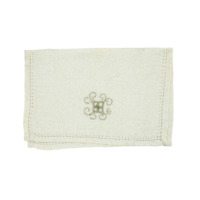 Embroidered linen napkin
Embroidered linen napkin This napkin was meticulously hemmed and embroidered by Alva Myrdal. Sewing was a valuable and relaxing pastime for her, and she kept on doing it well into her old age.
The napkin was donated to the Nobel Prize Museum by the Myrdal family in 2009.
-
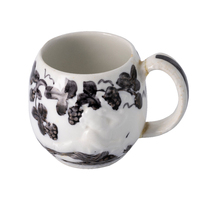 Mug
Mug This mug often stood on Alva Myrdal’s desk, including while she was working on the book The Game of Disarmament.
The mug was donated to the Nobel Prize Museum by Alva Myrdal's family in 2009.
-
 Typewriter
Typewriter This typewriter was used by Alva Myrdal while working on her book The Game of Disarmament, published in 1976.
A typewriter is associated primarily with writing and solitary thinking. These were also aspects of Alva Myrdal's life, although much of her work took place with an audience and at the negotiating table. With a background in psychology, sociology, and pedagogy, Alva Myrdal focused in the 1930s on family policy and social policy. From the 1950s, her career became increasingly international. She had several assignments for the UN. In particular, she engaged in peace and disarmament issues. As the leading Swedish delegate to the Disarmament Conference in Geneva (1962-1973), she worked to diminish the arms race between the superpowers. In addition to her involvement in peace efforts, she also worked intensely for gender equality.
The typewriter was donated the to the Nobel Prize Museum by the Myrdal family in 2009.
-
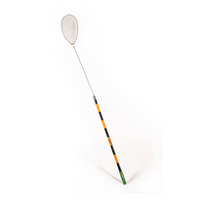 Net
Net Osamu Shimomura and his colleagues used this dip net to capture large numbers of the jellyfish Aequorea aequorea to extract a substance that makes their edges luminous. The net was made in 1968 and was designed to be light and easy to drag through water. The jellyfish had to be captured in the right direction to avoid damaging their edges. The handle was painted black and orange, the colours of Princeton University.
Osamu Shimomura donated the net to the Nobel Prize Museum in 2009.
-
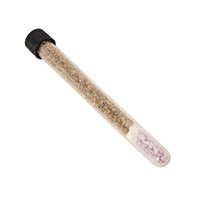 Test tube with dried Cypridina
Test tube with dried Cypridina Osamu Shimomura's research on luminous biological substances started with the small, shelled organism Cypridina hilgendorfii. The test tube contains dried specimens of the organism.
When the sand-like material is moistened, it becomes luminous. The material was collected by Japanese soldiers during the Second World War to make discreet sources of light. At the end of the war, the U.S. Navy took over the material, and it eventually ended up at Princeton University.
These luminous shelled organisms also caught the interest of Japanese researchers after the war. In 1955, the young chemist Osamu Shimomura was given the task of discovering why these animals were luminous. After extensive work, he managed to find the cause: a luminous protein. Shimomura would later pursue his research on luminous biological substances at Princeton University.
Osamu Shimomura donated the test tube to the Nobel Prize Museum in 2009.
-
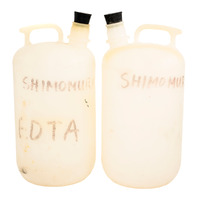 Plastic containers
Plastic containers These plastic containers were used by Osamu Shimomura and his colleagues to extract luminous substances from the jellyfish Aequorea aequorea. The containers held solutions of ammonium sulphate and the acid EDTA.
From thousands of jellyfish, Shimomura and his colleagues managed to extract a few grammes of a luminescent protein, aequorin. They also succeeded in extracting small amounts of another protein that creates a pale green light. This discovery of green fluorescent protein (GFP) would have a great importance for research. GFP enables the study of processes inside the cells of living organisms.
Osamu Shimomura donated the plastic containers to the Nobel Prize Museum in 2009.
-
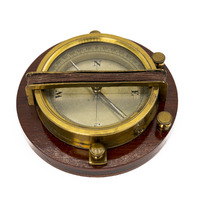 Compass
Compass Alfred Nobel's compass.
-
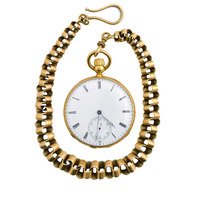 Pocket watch
Pocket watch Alfred Nobel's pocket watch was certainly important in his life. Travel and meetings characterized a large part of his life and required a reliable watch.
-
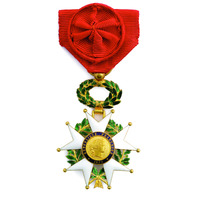 Insignia of the Legion of Honour
Insignia of the Legion of Honour Receiving the Legion of Honour served as confirmation of the position Alfred Nobel had reached in France. Nobel expressed multiple times that he did not personally consider the honors and awards particularly important, but he saw the business value associated with such recognition. At heart, he was perhaps also flattered at this evidence of appreciation.
-
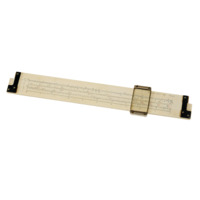 Slide rule
Slide rule Toshihide Maskawa first began using this slide rule as a high-school student. At the age of 17, he used it just after the launch of the first-ever satellite, Sputnik, in 1957, to calculate the trajectories of satellites and rockets, for example. Maskawa later delved deeper into the mathematics of quantum physics. In 1973, Maskawa got his first programmable calculator, and his slide rule was allowed to retire.
Toshihide Maskawa donated the slide rule to the Nobel Prize Museum in 2008.
-
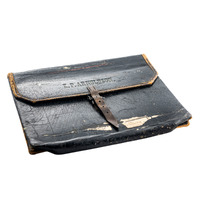 Briefcase
Briefcase This briefcase belonged to the writer and politician Klas Pontus Arnoldson, who worked to promote peace. As a member of the Swedish parliament, he advocated a policy of neutrality, that is, of declining to take sides with any party in armed conflicts. In 1883, Arnoldson founded the Swedish Peace and Arbitration Society (SPAS), and became its first secretary.
The briefcase was donated the to the Nobel Prize Museum by Klas Pontus Arnoldson’s family in 2008.
-
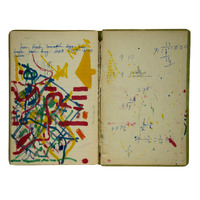 Notebook
Notebook A notebook kept by Roger Tsien when he was eight years old gives us insights into his view of the world and how his interests evolved during his childhood years. The notebook contains lists of countries and major cities, and drawings of complicated traffic junctions and famous bridges, which fascinated young Tsien. His father's work in the air force is also reflected in his lists of plane models. Tsien’s blossoming interest in chemistry is evident in the lists of basic elements, minerals, vitamins, and medicines, and in the many sketches of chemistry experiments he copied from a book. Some pages are filled with Chinese words, although Tsien found this quite boring.
Roger Tsien donated the notebook to the Nobel Prize Museum in 2008.
-
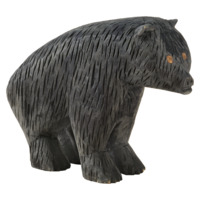 Wooden bear
Wooden bear For a long time this wooden bear stood on the writing desk from which Martti Ahtisaari, as President of Finland, diplomat, and peace negotiator, worked to promote a more peaceful world. It was a gift to him from disabled soldiers injured during the Russo-Finnish War of 1939 to 1940. The bear was made by war veteran Väinö Kekkonen from Karelia, the district from which Ahtisaari was forcibly evicted as a small boy during the war. The lives of the disabled soldiers who tried to defend Karelia did not always turn out as well as Ahtisaari’s life. “The bear symbolizes Finland. And perhaps also me,” explained Ahtisaari.
Martti Ahtisaari donated the wooden bear to the Nobel Prize Museum in 2008.
-
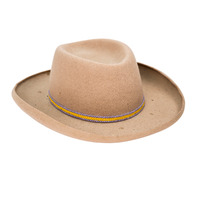 Hat
Hat This hat belonged to Gunnar Myrdal. It is a wide-brimmed felt hat, and he wore it in the 1960s.
The hat was donated to the Nobel Prize Museum by the Myrdal family in 2008.
-
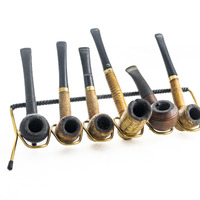 Smoking pipes in a rack
Smoking pipes in a rack This pipe rack and its pipes belonged to Gunnar Myrdal. He had them during his time as head of the Institute for International Economic Studies, which used to be in the Wenner-Gren Center in Stockholm. The IIES was founded in 1962, when a professorship was created especially for Gunnar Myrdal. He was its director until 1967.
The pipes and the pipe rack was donated to the Nobel Prize Museum by Gunnar Myrdal’s family in 2008.
-
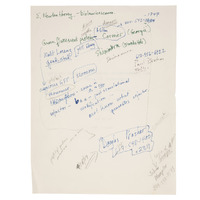 Notes
Notes This paper contains notes from a seminar that was crucial to Martin Chalfie's research.
In the late 1980s, “Neurolunch” seminars were held every Tuesday at 12.00 pm at the Department of Biological Sciences, Columbia University. On 25 April 1989, Paul Brehm held a presentation on bioluminescent organisms that was pivotal to Martin Chalfie’s research. Chalfie realised the possibility of using green fluorescent protein as a marker for gene expression in his research. His notes are scribbled on this paper, including names of scientists in the field. One of them is “Shimomura”. Osamu Shimomura, Roger Tsien and Martin Chalfie later shared the 2008 Nobel Prize in Chemistry.
Martin Chalfie donated the notes to the Nobel Prize Museum in 2008.
-
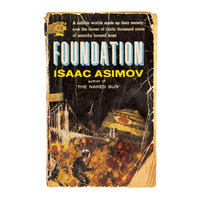 Foundation by Isaac Asimov
Foundation by Isaac Asimov Roger Myerson read Isaac Asimov's science fiction novel _The Foundation_ when he was twelve years old. The book inspired him to later pursue a career in mathematical social science.
Roger Myerson donated the book to the Nobel Prize Museum in 2007.
-
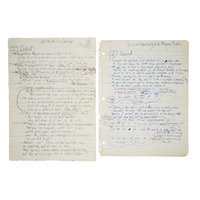 Manuscripts
Manuscripts These manuscripts are the handwritten originals of two of Roger Myerson's most seminal scientific publications: "Incentive Compatibility and the Bargaining Problem" from 1979, and "Optimal Auction Design" from 1981.
Roger Myerson donated the manuscripts to the Nobel Prize Museum in 2007.
-
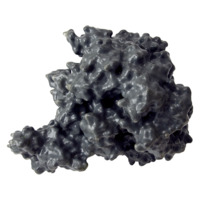 Model of RNA polymerase
Model of RNA polymerase This model, donated by Roger Kornberg, shows the structure of RNA polymerase, a molecule that plays an important role in one of life’s most fundamental processes. The molecule is an enzyme, a substance that speeds up chemical processes. This particular enzyme is active in transferring genetic information stored in DNA molecules to RNA molecules. Through a kind of bubble in the RNA polymerase molecule, a long RNA molecule is assembled. The sequence of the RNA chain’s component parts is determined by a DNA molecule, which is translated inside the RNA polymerase molecule's cavity.
Roger Kornberg donated the model to the Nobel Prize Museum in 2006.
-
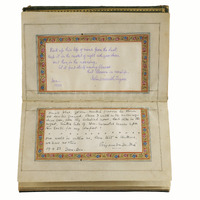 Booklet
Booklet Some objects have a remarkable history. This small book contains the thoughts and poems of Rabindranath Tagore and members of his family. Among them are a hand-written poem by Tagore, who gave the book to Andrée Karpelès Hogman in 1923. Andrée Karpelès was an artist from France who spent a few years in Santiniketan, where Tagore ran a school. It was there that she both painted and translated Tagore's poems into French. After the end of the Second World War, Karpelès and her husband adopted a girl who had lost her father while fleeing from the Nazis, and her mother in a concentration camp. The book later became the property of their adopted daughter, Flora Hogman, who eventually settled in New York. When one of the Nobel Prize Museum's staff, Margrit Wettstein, came into contact with Flora Hogman in the course of her research, Hogman offered to donate the book to the Nobel Prize Museum. The book was given to the museum in 2007.
-
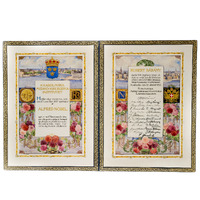 Robert Bárány's Nobel Prize diploma
Robert Bárány's Nobel Prize diploma Robert Bárány was awarded the 1914 Nobel Prize in Physiology or Medicine. His Nobel Prize diploma was designed by artist Anna Berglund.
The diploma was donated to the Nobel Prize Museum by the Bárány family in 2007.
-
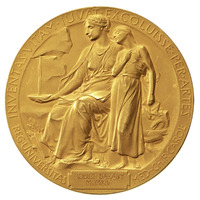 Robert Bárány's Nobel Prize medal
Robert Bárány's Nobel Prize medal Robert Bárány was awarded the 1914 Nobel Prize in Physiology or Medicine.
Bárány's Nobel Prize medal was donated to the Nobel Prize Museum by his family in 2007.
-
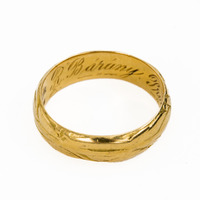 Doctoral ring
Doctoral ring This doctoral ring belonged to Robert Bárány, who received an honorary doctorate at the Karolinska Institutet in 1924. In the Scandinavian countries, a doctor is traditionally entitled to wear a ring, which symbolizes the bond between the doctor and science.
The ring was donated to the Nobel Prize Museum by Robert Bárány's family in 2007.
-
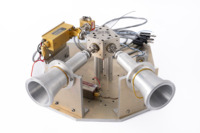 Antenna prototype
Antenna prototype This instrument is a prototype intended for the COBE satellite, which was used to measure cosmic background radiation. George Smoot and his research team were able to use data from the COBE in 1992 to show minor variations in radiation from different directions. This was a clue to how stars and other celestial bodies were created.
The variations can be explained by quantum fluctuations which cause particles to form lumps in the universe. These then continued to grow due to gravity.
The antenna prototype was presented to the Nobel Prize Museum in 2006 by George Smoot and NASA.
-
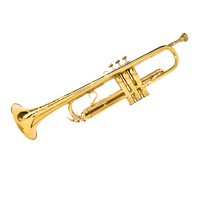 Trumpet
Trumpet Edmund Phelps learnt to play the trumpet as a teenager, and it became his passion. Music gave him a creative outlet. A course in which he was asked to improvise using a C major scale helped Phelps realise that all of us can find inspiration where least expected. Phelps played in various groups and was happy to take the lead. Would he perhaps become the head of an organisation? Phelps came to the conclusion that he was not talented enough for a career in music and chose to study humanities. But he did attend one course in economics. This sparked his interest and was the first step in his research career in economics. Phelps continued to entertain friends and family with his musical talents, including singing.
Edmund Phelps donated the trumpet to the Nobel Prize Museum in 2006.
 Mortar and pestle As president of Liberia, Ellen Johnson Sirleaf has worked to promote peace, reconciliation and social and economic development. This mortar and pestle was given to her by rural women farmers as a gift. Ellen Johnson Sirleaf donated the mortar to the Nobel Prize Museum in 2011.
Mortar and pestle As president of Liberia, Ellen Johnson Sirleaf has worked to promote peace, reconciliation and social and economic development. This mortar and pestle was given to her by rural women farmers as a gift. Ellen Johnson Sirleaf donated the mortar to the Nobel Prize Museum in 2011. Hard-times token This token was given to Thomas Sargent by his grandfather and was the key object that sparked his interest in economics. Hard-times tokens were privately issued, unofficial currency. They were issued in the U.S. during the financial and political turmoil of 1833-1843. Hard-times tokens often had a satirical political content. This particular token, issued in 1834, is advocating against President Andrew Jackson. Sargent has subsequently published papers on the history and development of economics in the U.S. Thomas Sargent donated the token to the Nobel Prize Museum in 2011.
Hard-times token This token was given to Thomas Sargent by his grandfather and was the key object that sparked his interest in economics. Hard-times tokens were privately issued, unofficial currency. They were issued in the U.S. during the financial and political turmoil of 1833-1843. Hard-times tokens often had a satirical political content. This particular token, issued in 1834, is advocating against President Andrew Jackson. Sargent has subsequently published papers on the history and development of economics in the U.S. Thomas Sargent donated the token to the Nobel Prize Museum in 2011. Medal This medal, the Belden Mathematical Prize, was awarded to Moses Greenfield in 1935, on the occasion of being the second best mathematics student in the New York City public schools. Greenfield is Thomas Sargent’s father-in-law and gave him this medal after they co-authored a research paper in 1993. Thomas Sargent donated the medal to the Nobel Prize Museum in 2011.
Medal This medal, the Belden Mathematical Prize, was awarded to Moses Greenfield in 1935, on the occasion of being the second best mathematics student in the New York City public schools. Greenfield is Thomas Sargent’s father-in-law and gave him this medal after they co-authored a research paper in 1993. Thomas Sargent donated the medal to the Nobel Prize Museum in 2011. T-shirt This T-shirt is from the Minnesota Economics Department at the University of Minnesota, where Thomas Sargent worked in the 1970s and 1980s. The image is a paraphrase of Eugène Delacroix’s painting "Liberty Leading the People", which celebrates the July Revolution in France in 1830. Instead of the national motto of France, “Liberté, Égalité, Fraternité” (“Liberté, égalité, fraternité”) it says “Equilîbrité, Optimâlité, Calîbrité”, which is faux-french for “Equilbrium, Optimality, Calibration” – key concepts in econometrics. Thomas Sargent donated the T-shirt to the Nobel Prize Museum in 2011.
T-shirt This T-shirt is from the Minnesota Economics Department at the University of Minnesota, where Thomas Sargent worked in the 1970s and 1980s. The image is a paraphrase of Eugène Delacroix’s painting "Liberty Leading the People", which celebrates the July Revolution in France in 1830. Instead of the national motto of France, “Liberté, Égalité, Fraternité” (“Liberté, égalité, fraternité”) it says “Equilîbrité, Optimâlité, Calîbrité”, which is faux-french for “Equilbrium, Optimality, Calibration” – key concepts in econometrics. Thomas Sargent donated the T-shirt to the Nobel Prize Museum in 2011. Cufflinks In the lead-up to the Nobel Prize award ceremony 2011, physics laureate Adam Riess had cufflinks made for himself and the 18 members of his research team. The cufflinks have a formula, “q0<0”, engraved on them. The meaning of the formula is that our universe is expanding at an ever-increasing rate. This was the discovery that Riess and his co-laureates were awarded the physics prize for. Riess commissioned the cufflinks seen here before ordering a pair for each researcher. He donated the prototypes to the Nobel Prize Museum 2011.
Cufflinks In the lead-up to the Nobel Prize award ceremony 2011, physics laureate Adam Riess had cufflinks made for himself and the 18 members of his research team. The cufflinks have a formula, “q0<0”, engraved on them. The meaning of the formula is that our universe is expanding at an ever-increasing rate. This was the discovery that Riess and his co-laureates were awarded the physics prize for. Riess commissioned the cufflinks seen here before ordering a pair for each researcher. He donated the prototypes to the Nobel Prize Museum 2011. Tie The pattern on this tie is a quasicrystal, a structure that is ordered but not periodic. Physicists had long agreed that all crystal structures followed a periodic pattern, and , Dan Shechtman met with scepticism in 1982, when he showed that quasicrystals existed. It eventually turned out that he was right, and he was awarded the 2011 Nobel Prize in Chemistry for this discovery. Shechtman received the tie for his 70th birthday from the Technion – Israel Institute of Technology in Haifa, whose vice-chancellor Peretz Lavie had had it custom-made. Dan Shechtman donated the tie to the Nobel Prize Museum in 2011.
Tie The pattern on this tie is a quasicrystal, a structure that is ordered but not periodic. Physicists had long agreed that all crystal structures followed a periodic pattern, and , Dan Shechtman met with scepticism in 1982, when he showed that quasicrystals existed. It eventually turned out that he was right, and he was awarded the 2011 Nobel Prize in Chemistry for this discovery. Shechtman received the tie for his 70th birthday from the Technion – Israel Institute of Technology in Haifa, whose vice-chancellor Peretz Lavie had had it custom-made. Dan Shechtman donated the tie to the Nobel Prize Museum in 2011. Apparatus Arvid Carlsson and his colleagues designed this device for cleaning tissue extract and isolating dopamine and other substances. Cleaning takes place by pressing the extract through an ion exchange column thatcan take up and bind the dopamine. Thereafter, a liquid is pressed through the column. The liquid releases the dopamine and separates other components. This enables a subsequent determination of the amount of dopamine. Arvid Carlsson donated the apparatus to the Nobel Prize Museum in 2011.
Apparatus Arvid Carlsson and his colleagues designed this device for cleaning tissue extract and isolating dopamine and other substances. Cleaning takes place by pressing the extract through an ion exchange column thatcan take up and bind the dopamine. Thereafter, a liquid is pressed through the column. The liquid releases the dopamine and separates other components. This enables a subsequent determination of the amount of dopamine. Arvid Carlsson donated the apparatus to the Nobel Prize Museum in 2011. Rosary This rosary, a japa mala, is an eastern rosary with 108 beads, used in both Buddhism and Hinduism for counting mantras. The 14th Dalai Lama donated the rosary to the Nobel Prize Museum in 2011.
Rosary This rosary, a japa mala, is an eastern rosary with 108 beads, used in both Buddhism and Hinduism for counting mantras. The 14th Dalai Lama donated the rosary to the Nobel Prize Museum in 2011. Glasses One of the first things you notice about Tenzin Gyatso, the Fourteenth Dalai Lama of Tibet, is his glasses. Does the Dalai Lama see the world differently than we do? For the Dalai Lama, the cultivation of inner peace and integrity is the ultimate means of achieving positive change in an irrational world. Tolerance and understanding are the key components in his world view. The Dalai Lama donated the glasses to the Nobel Prize Museum in 2011.
Glasses One of the first things you notice about Tenzin Gyatso, the Fourteenth Dalai Lama of Tibet, is his glasses. Does the Dalai Lama see the world differently than we do? For the Dalai Lama, the cultivation of inner peace and integrity is the ultimate means of achieving positive change in an irrational world. Tolerance and understanding are the key components in his world view. The Dalai Lama donated the glasses to the Nobel Prize Museum in 2011. Sutra Even today’s world, the Dalai Lama finds wisdom and inspiration in a sutra with old Buddhist texts. For the Dalai Lama, the cultivation of inner peace and integrity is the ultimate means of achieving positive change in an irrational world. In his Nobel Prize lecture, he said, “Inner peace is the key: if you have inner peace, the external problems do not affect your deep sense of peace and tranquility. In that state of mind, you can deal with situations with calmness and reason, while keeping your inner happiness.” The 14th Dalai Lama donated the sutra to the Nobel Prize Museum in 2001.
Sutra Even today’s world, the Dalai Lama finds wisdom and inspiration in a sutra with old Buddhist texts. For the Dalai Lama, the cultivation of inner peace and integrity is the ultimate means of achieving positive change in an irrational world. In his Nobel Prize lecture, he said, “Inner peace is the key: if you have inner peace, the external problems do not affect your deep sense of peace and tranquility. In that state of mind, you can deal with situations with calmness and reason, while keeping your inner happiness.” The 14th Dalai Lama donated the sutra to the Nobel Prize Museum in 2001. Fountain pen Pennan har tillhört den 14:e Dalai Lama. Dalai lama donerade pennan till Nobelprismuseet 2011.
Fountain pen Pennan har tillhört den 14:e Dalai Lama. Dalai lama donerade pennan till Nobelprismuseet 2011. Workbench This workbench is from the workshop at the former Lenin Shipyard in Gdansk, where Lech Wałęsa worked as an electrician. The independent trade union Solidarity was established after a major strike in Poland in 1980. Wałęsa was one of its founders and became its leader and spokesperson. Solidarity was crucial in developments that eventually led to the fall of the communist regimes in Eastern Europe. Wałęsa was elected president of Poland in 1990. The massive weight of the workbench is a reminder of Wałęsa’s background as a worker but also symbolises the force of the upheavals that he helped instigate. The bench was donated to the Nobel Prize Museum in 2010 by the shipyard in Gdansk in connection with an art installation by Grzegorz Klaman at the museum.
Workbench This workbench is from the workshop at the former Lenin Shipyard in Gdansk, where Lech Wałęsa worked as an electrician. The independent trade union Solidarity was established after a major strike in Poland in 1980. Wałęsa was one of its founders and became its leader and spokesperson. Solidarity was crucial in developments that eventually led to the fall of the communist regimes in Eastern Europe. Wałęsa was elected president of Poland in 1990. The massive weight of the workbench is a reminder of Wałęsa’s background as a worker but also symbolises the force of the upheavals that he helped instigate. The bench was donated to the Nobel Prize Museum in 2010 by the shipyard in Gdansk in connection with an art installation by Grzegorz Klaman at the museum. T-shirt T-tröjan utformades av Peter Diamonds doktorander till hans 70-årsdag 2010. Den bär hans namn DIAMOND och heminstitution MIT ECON. Typsnittet är det som används av baseboll-laget Boston Red Sox, som Diamond hängivet hållit på sedan 1949. Som många andra amerikanska pojkar fördjupade han sig i statistik om spelare och matcher, vilket ledde till en hel del huvudräkning. Även senare fick han genom sitt basebollintresse, särskilt genom baseboll-statistikern Bill James analyser, mycket erfarenhet och kunskap om statistiska samband och hur man kan dra slutsatser från tillgänglig information. I samband med 70-årsdagen ordnade Diamonds fru så att han fick kasta den första pitchen vid en av Boston Red Sox matcher. Många doktorander och lärare vid MIT närvarade iklädda den för Diamond särskilt formgivna tröjan. När Diamond senare samma år utsågs till ekonomipristagare bar många kolleger sina tröjor vid firandet på institutionen. Peter Diamond donerade tröjan till Nobelprismuseet 2010.
T-shirt T-tröjan utformades av Peter Diamonds doktorander till hans 70-årsdag 2010. Den bär hans namn DIAMOND och heminstitution MIT ECON. Typsnittet är det som används av baseboll-laget Boston Red Sox, som Diamond hängivet hållit på sedan 1949. Som många andra amerikanska pojkar fördjupade han sig i statistik om spelare och matcher, vilket ledde till en hel del huvudräkning. Även senare fick han genom sitt basebollintresse, särskilt genom baseboll-statistikern Bill James analyser, mycket erfarenhet och kunskap om statistiska samband och hur man kan dra slutsatser från tillgänglig information. I samband med 70-årsdagen ordnade Diamonds fru så att han fick kasta den första pitchen vid en av Boston Red Sox matcher. Många doktorander och lärare vid MIT närvarade iklädda den för Diamond särskilt formgivna tröjan. När Diamond senare samma år utsågs till ekonomipristagare bar många kolleger sina tröjor vid firandet på institutionen. Peter Diamond donerade tröjan till Nobelprismuseet 2010. Graphite, tape dispenser and electronic device Using ordinary tape and a piece of graphite, Andre Geim and Konstantin Novoselov conducted an experiment with surprising results. Graphite is a form of carbon that is used in pencils, for example. Physicists had calculated that layers of graphite just one atom thick would have interesting properties, but it was considered impossible to produce in reality. Nevertheless, Geim and Novoselov attempted to separate thin flakes of carbon from a piece of graphite using ordinary tape. Some of these flakes were extremely thin. The new material – “graphene” – had been created. This device is one of the first where graphene was used. Andre Geim and Konstantin Novoselov donated the graphite, tape dispenser and electronic device to the Nobel Prize Museum in 2010.
Graphite, tape dispenser and electronic device Using ordinary tape and a piece of graphite, Andre Geim and Konstantin Novoselov conducted an experiment with surprising results. Graphite is a form of carbon that is used in pencils, for example. Physicists had calculated that layers of graphite just one atom thick would have interesting properties, but it was considered impossible to produce in reality. Nevertheless, Geim and Novoselov attempted to separate thin flakes of carbon from a piece of graphite using ordinary tape. Some of these flakes were extremely thin. The new material – “graphene” – had been created. This device is one of the first where graphene was used. Andre Geim and Konstantin Novoselov donated the graphite, tape dispenser and electronic device to the Nobel Prize Museum in 2010. Notepad A notepad is often an author’s most important tool. This one originally belonged to Mario Vargas Llosa. It was given to him by El País, Spain’s largest newspaper, to which Vargas Llosa sometimes contributes. Vargas Llosa often takes part in discourse on current issues. He wrote about world events that took place in 2004 in this notepad. Apart from writing, he has also been politically active, running for president in his native Peru in 1990. Mario Vargas Llosa donated the notepad to the Nobel Prize Museum in 2010.
Notepad A notepad is often an author’s most important tool. This one originally belonged to Mario Vargas Llosa. It was given to him by El País, Spain’s largest newspaper, to which Vargas Llosa sometimes contributes. Vargas Llosa often takes part in discourse on current issues. He wrote about world events that took place in 2004 in this notepad. Apart from writing, he has also been politically active, running for president in his native Peru in 1990. Mario Vargas Llosa donated the notepad to the Nobel Prize Museum in 2010. Wooden hippopotamus Mario Vargas Llosa has a large collection of hippopotami at home. They even occur in his literary works, as in the play Kathie and the Hippopotamus. Vargas Llosa took a particular liking to a story about a baby hippopotamus that lost its mother when the tsunami hit Kenya in 2004. The baby hippopotamus began searching for a new mother and made an unexpected choice – a 100-year-old tortoise! The tortoise took care of the baby hippo and, when the hippo was fully-grown, it cared for the aged tortoise. Vargas Llosa suggests we should be more like the hippo and the tortoise. Mario Vargas Llosa donated the hippopotamus to the Nobel Prize Museum in 2010.
Wooden hippopotamus Mario Vargas Llosa has a large collection of hippopotami at home. They even occur in his literary works, as in the play Kathie and the Hippopotamus. Vargas Llosa took a particular liking to a story about a baby hippopotamus that lost its mother when the tsunami hit Kenya in 2004. The baby hippopotamus began searching for a new mother and made an unexpected choice – a 100-year-old tortoise! The tortoise took care of the baby hippo and, when the hippo was fully-grown, it cared for the aged tortoise. Vargas Llosa suggests we should be more like the hippo and the tortoise. Mario Vargas Llosa donated the hippopotamus to the Nobel Prize Museum in 2010. Long Sleeve T-Shirt På Oliver Williamsons tröja återfinns ett motto "agete sine periculo", vilket betyder "agera försiktigt". Oliver Williamson donerade tröjan till Nobelprismuseet 2009.
Long Sleeve T-Shirt På Oliver Williamsons tröja återfinns ett motto "agete sine periculo", vilket betyder "agera försiktigt". Oliver Williamson donerade tröjan till Nobelprismuseet 2009. Pipe holder The pipe holder was Oliver Williamson's companion when he wrote one of his major works, Transaction Cost Economics, during the 1970s. Oliver Williamson donated the pipe holder to the Nobel Prize Museum in 2009.
Pipe holder The pipe holder was Oliver Williamson's companion when he wrote one of his major works, Transaction Cost Economics, during the 1970s. Oliver Williamson donated the pipe holder to the Nobel Prize Museum in 2009. Baseball mitt Baseball was a sport dear to Oliver Williamson's heart. The mitt also had a special meaning to him because baseball taught him a lot about the importance of teamwork. Oliver Williamson donated the baseball mitt to the Nobel Prize Museum in 2009.
Baseball mitt Baseball was a sport dear to Oliver Williamson's heart. The mitt also had a special meaning to him because baseball taught him a lot about the importance of teamwork. Oliver Williamson donated the baseball mitt to the Nobel Prize Museum in 2009. Film reel The film, from 1966, shows Charles Kao during his early experiments with optical fibres conducted at the British telecom company Standard Telecommunication Laboratories. Kao's findings from the experiments were that optical fibres could be used for efficient transfer of information, if only the glass they were made of could be purified. This was eventually made possible, and a large part of our communication today is through optical fibres. The film was donated to the Nobel Prize Museum by Richard Epworth at Standard Telecommunication Laboratories when Kao was awarded the Nobel Prize in Physics in 2009.
Film reel The film, from 1966, shows Charles Kao during his early experiments with optical fibres conducted at the British telecom company Standard Telecommunication Laboratories. Kao's findings from the experiments were that optical fibres could be used for efficient transfer of information, if only the glass they were made of could be purified. This was eventually made possible, and a large part of our communication today is through optical fibres. The film was donated to the Nobel Prize Museum by Richard Epworth at Standard Telecommunication Laboratories when Kao was awarded the Nobel Prize in Physics in 2009. Book by Albert Einstein and Leopold Infeld The Evolution of Physics is a popular science book by Albert Einstein and Leopold Infeld. Reading a Japanese edition of it as a high school student it inspired Makato Kobayashi to pursue the study of physics. Makato Kobayashi donated the books to the Nobel Prize Museum in 2009.
Book by Albert Einstein and Leopold Infeld The Evolution of Physics is a popular science book by Albert Einstein and Leopold Infeld. Reading a Japanese edition of it as a high school student it inspired Makato Kobayashi to pursue the study of physics. Makato Kobayashi donated the books to the Nobel Prize Museum in 2009. Model of a ribosome This model represents a ribosome. The ribosomes in our cells are where one of the most fundamental processes in the chemistry of life takes place: the production of proteins based on the genetic information in RNA molecules. The highly complex ribosome structure could be mapped thanks to the efforts of many scientists, including Thomas Steitz, Venkatraman Ramakrishnan and Ada Yonath. Thomas Steitz donated the model to the Nobel Prize Museum in 2009.
Model of a ribosome This model represents a ribosome. The ribosomes in our cells are where one of the most fundamental processes in the chemistry of life takes place: the production of proteins based on the genetic information in RNA molecules. The highly complex ribosome structure could be mapped thanks to the efforts of many scientists, including Thomas Steitz, Venkatraman Ramakrishnan and Ada Yonath. Thomas Steitz donated the model to the Nobel Prize Museum in 2009. Seed of a Tambalacoque tree Can an authorship be symbolised by a nut? Jean-Marie Gustave Le Clézio picked this nut from one of the few surviving tambalacoque trees on the island of Mauritius. According to legend, the seeds of this tree were once spread via the droppings of the dodo. When the Europeans arrived on the island in the 1600s, all the dodos were gradually killed and the seeds of the tambalacoque tree could no longer germinate. Le Clézio often writes about the encounter of Western and other cultures. He is often critical of the way Europeans have treated peoples in other parts of the world. Jean Marie Gustave Le Clézio donated the nut and the letter to the Nobel Prize Museum in 2009.
Seed of a Tambalacoque tree Can an authorship be symbolised by a nut? Jean-Marie Gustave Le Clézio picked this nut from one of the few surviving tambalacoque trees on the island of Mauritius. According to legend, the seeds of this tree were once spread via the droppings of the dodo. When the Europeans arrived on the island in the 1600s, all the dodos were gradually killed and the seeds of the tambalacoque tree could no longer germinate. Le Clézio often writes about the encounter of Western and other cultures. He is often critical of the way Europeans have treated peoples in other parts of the world. Jean Marie Gustave Le Clézio donated the nut and the letter to the Nobel Prize Museum in 2009. Nail scissors These scissors suggest an experimental approach to writing poetry. When she is not writing novels, Herta Müller creates poetry in the form of collage. She cuts out words and phrases from printed texts and arranges them in new combinations and images. The nail scissors were used when she first began creating her collages. When a travelling cutler came to Müller's neighborhood, she left her scissors with him for sharpening. However, when he returned the scissors, one of the blades was crooked. When her husband tried to bend it back into shape, it broke off. In despair, she began searching for a new pair. Herta Müller donated the scissors to the Nobel Prize Museum in 2009.
Nail scissors These scissors suggest an experimental approach to writing poetry. When she is not writing novels, Herta Müller creates poetry in the form of collage. She cuts out words and phrases from printed texts and arranges them in new combinations and images. The nail scissors were used when she first began creating her collages. When a travelling cutler came to Müller's neighborhood, she left her scissors with him for sharpening. However, when he returned the scissors, one of the blades was crooked. When her husband tried to bend it back into shape, it broke off. In despair, she began searching for a new pair. Herta Müller donated the scissors to the Nobel Prize Museum in 2009. Model of a ribosome The model is a simplified representation of a ribosome – one of many refined and complex structures found in our cells. A ribosome consists of hundreds of thousands of atoms. Mapping all of their positions in detail was generally considered impossible when Ada Yonath began her work. But it wasn't! In this model, the red string represents an mRNA molecule, which transfers the genetic code to the ribosome. The blue string represents a protein produced by the ribosome. Ada Yonath donated the model to the Nobel Prize Museum in 2009.
Model of a ribosome The model is a simplified representation of a ribosome – one of many refined and complex structures found in our cells. A ribosome consists of hundreds of thousands of atoms. Mapping all of their positions in detail was generally considered impossible when Ada Yonath began her work. But it wasn't! In this model, the red string represents an mRNA molecule, which transfers the genetic code to the ribosome. The blue string represents a protein produced by the ribosome. Ada Yonath donated the model to the Nobel Prize Museum in 2009. Embroidered linen napkin This napkin was meticulously hemmed and embroidered by Alva Myrdal. Sewing was a valuable and relaxing pastime for her, and she kept on doing it well into her old age. The napkin was donated to the Nobel Prize Museum by the Myrdal family in 2009.
Embroidered linen napkin This napkin was meticulously hemmed and embroidered by Alva Myrdal. Sewing was a valuable and relaxing pastime for her, and she kept on doing it well into her old age. The napkin was donated to the Nobel Prize Museum by the Myrdal family in 2009. Mug This mug often stood on Alva Myrdal’s desk, including while she was working on the book The Game of Disarmament. The mug was donated to the Nobel Prize Museum by Alva Myrdal's family in 2009.
Mug This mug often stood on Alva Myrdal’s desk, including while she was working on the book The Game of Disarmament. The mug was donated to the Nobel Prize Museum by Alva Myrdal's family in 2009. Typewriter This typewriter was used by Alva Myrdal while working on her book The Game of Disarmament, published in 1976. A typewriter is associated primarily with writing and solitary thinking. These were also aspects of Alva Myrdal's life, although much of her work took place with an audience and at the negotiating table. With a background in psychology, sociology, and pedagogy, Alva Myrdal focused in the 1930s on family policy and social policy. From the 1950s, her career became increasingly international. She had several assignments for the UN. In particular, she engaged in peace and disarmament issues. As the leading Swedish delegate to the Disarmament Conference in Geneva (1962-1973), she worked to diminish the arms race between the superpowers. In addition to her involvement in peace efforts, she also worked intensely for gender equality. The typewriter was donated the to the Nobel Prize Museum by the Myrdal family in 2009.
Typewriter This typewriter was used by Alva Myrdal while working on her book The Game of Disarmament, published in 1976. A typewriter is associated primarily with writing and solitary thinking. These were also aspects of Alva Myrdal's life, although much of her work took place with an audience and at the negotiating table. With a background in psychology, sociology, and pedagogy, Alva Myrdal focused in the 1930s on family policy and social policy. From the 1950s, her career became increasingly international. She had several assignments for the UN. In particular, she engaged in peace and disarmament issues. As the leading Swedish delegate to the Disarmament Conference in Geneva (1962-1973), she worked to diminish the arms race between the superpowers. In addition to her involvement in peace efforts, she also worked intensely for gender equality. The typewriter was donated the to the Nobel Prize Museum by the Myrdal family in 2009. Net Osamu Shimomura and his colleagues used this dip net to capture large numbers of the jellyfish Aequorea aequorea to extract a substance that makes their edges luminous. The net was made in 1968 and was designed to be light and easy to drag through water. The jellyfish had to be captured in the right direction to avoid damaging their edges. The handle was painted black and orange, the colours of Princeton University. Osamu Shimomura donated the net to the Nobel Prize Museum in 2009.
Net Osamu Shimomura and his colleagues used this dip net to capture large numbers of the jellyfish Aequorea aequorea to extract a substance that makes their edges luminous. The net was made in 1968 and was designed to be light and easy to drag through water. The jellyfish had to be captured in the right direction to avoid damaging their edges. The handle was painted black and orange, the colours of Princeton University. Osamu Shimomura donated the net to the Nobel Prize Museum in 2009. Test tube with dried Cypridina Osamu Shimomura's research on luminous biological substances started with the small, shelled organism Cypridina hilgendorfii. The test tube contains dried specimens of the organism. When the sand-like material is moistened, it becomes luminous. The material was collected by Japanese soldiers during the Second World War to make discreet sources of light. At the end of the war, the U.S. Navy took over the material, and it eventually ended up at Princeton University. These luminous shelled organisms also caught the interest of Japanese researchers after the war. In 1955, the young chemist Osamu Shimomura was given the task of discovering why these animals were luminous. After extensive work, he managed to find the cause: a luminous protein. Shimomura would later pursue his research on luminous biological substances at Princeton University. Osamu Shimomura donated the test tube to the Nobel Prize Museum in 2009.
Test tube with dried Cypridina Osamu Shimomura's research on luminous biological substances started with the small, shelled organism Cypridina hilgendorfii. The test tube contains dried specimens of the organism. When the sand-like material is moistened, it becomes luminous. The material was collected by Japanese soldiers during the Second World War to make discreet sources of light. At the end of the war, the U.S. Navy took over the material, and it eventually ended up at Princeton University. These luminous shelled organisms also caught the interest of Japanese researchers after the war. In 1955, the young chemist Osamu Shimomura was given the task of discovering why these animals were luminous. After extensive work, he managed to find the cause: a luminous protein. Shimomura would later pursue his research on luminous biological substances at Princeton University. Osamu Shimomura donated the test tube to the Nobel Prize Museum in 2009. Plastic containers These plastic containers were used by Osamu Shimomura and his colleagues to extract luminous substances from the jellyfish Aequorea aequorea. The containers held solutions of ammonium sulphate and the acid EDTA. From thousands of jellyfish, Shimomura and his colleagues managed to extract a few grammes of a luminescent protein, aequorin. They also succeeded in extracting small amounts of another protein that creates a pale green light. This discovery of green fluorescent protein (GFP) would have a great importance for research. GFP enables the study of processes inside the cells of living organisms. Osamu Shimomura donated the plastic containers to the Nobel Prize Museum in 2009.
Plastic containers These plastic containers were used by Osamu Shimomura and his colleagues to extract luminous substances from the jellyfish Aequorea aequorea. The containers held solutions of ammonium sulphate and the acid EDTA. From thousands of jellyfish, Shimomura and his colleagues managed to extract a few grammes of a luminescent protein, aequorin. They also succeeded in extracting small amounts of another protein that creates a pale green light. This discovery of green fluorescent protein (GFP) would have a great importance for research. GFP enables the study of processes inside the cells of living organisms. Osamu Shimomura donated the plastic containers to the Nobel Prize Museum in 2009. Compass Alfred Nobel's compass.
Compass Alfred Nobel's compass. Pocket watch Alfred Nobel's pocket watch was certainly important in his life. Travel and meetings characterized a large part of his life and required a reliable watch.
Pocket watch Alfred Nobel's pocket watch was certainly important in his life. Travel and meetings characterized a large part of his life and required a reliable watch. Insignia of the Legion of Honour Receiving the Legion of Honour served as confirmation of the position Alfred Nobel had reached in France. Nobel expressed multiple times that he did not personally consider the honors and awards particularly important, but he saw the business value associated with such recognition. At heart, he was perhaps also flattered at this evidence of appreciation.
Insignia of the Legion of Honour Receiving the Legion of Honour served as confirmation of the position Alfred Nobel had reached in France. Nobel expressed multiple times that he did not personally consider the honors and awards particularly important, but he saw the business value associated with such recognition. At heart, he was perhaps also flattered at this evidence of appreciation. Slide rule Toshihide Maskawa first began using this slide rule as a high-school student. At the age of 17, he used it just after the launch of the first-ever satellite, Sputnik, in 1957, to calculate the trajectories of satellites and rockets, for example. Maskawa later delved deeper into the mathematics of quantum physics. In 1973, Maskawa got his first programmable calculator, and his slide rule was allowed to retire. Toshihide Maskawa donated the slide rule to the Nobel Prize Museum in 2008.
Slide rule Toshihide Maskawa first began using this slide rule as a high-school student. At the age of 17, he used it just after the launch of the first-ever satellite, Sputnik, in 1957, to calculate the trajectories of satellites and rockets, for example. Maskawa later delved deeper into the mathematics of quantum physics. In 1973, Maskawa got his first programmable calculator, and his slide rule was allowed to retire. Toshihide Maskawa donated the slide rule to the Nobel Prize Museum in 2008. Briefcase This briefcase belonged to the writer and politician Klas Pontus Arnoldson, who worked to promote peace. As a member of the Swedish parliament, he advocated a policy of neutrality, that is, of declining to take sides with any party in armed conflicts. In 1883, Arnoldson founded the Swedish Peace and Arbitration Society (SPAS), and became its first secretary. The briefcase was donated the to the Nobel Prize Museum by Klas Pontus Arnoldson’s family in 2008.
Briefcase This briefcase belonged to the writer and politician Klas Pontus Arnoldson, who worked to promote peace. As a member of the Swedish parliament, he advocated a policy of neutrality, that is, of declining to take sides with any party in armed conflicts. In 1883, Arnoldson founded the Swedish Peace and Arbitration Society (SPAS), and became its first secretary. The briefcase was donated the to the Nobel Prize Museum by Klas Pontus Arnoldson’s family in 2008. Notebook A notebook kept by Roger Tsien when he was eight years old gives us insights into his view of the world and how his interests evolved during his childhood years. The notebook contains lists of countries and major cities, and drawings of complicated traffic junctions and famous bridges, which fascinated young Tsien. His father's work in the air force is also reflected in his lists of plane models. Tsien’s blossoming interest in chemistry is evident in the lists of basic elements, minerals, vitamins, and medicines, and in the many sketches of chemistry experiments he copied from a book. Some pages are filled with Chinese words, although Tsien found this quite boring. Roger Tsien donated the notebook to the Nobel Prize Museum in 2008.
Notebook A notebook kept by Roger Tsien when he was eight years old gives us insights into his view of the world and how his interests evolved during his childhood years. The notebook contains lists of countries and major cities, and drawings of complicated traffic junctions and famous bridges, which fascinated young Tsien. His father's work in the air force is also reflected in his lists of plane models. Tsien’s blossoming interest in chemistry is evident in the lists of basic elements, minerals, vitamins, and medicines, and in the many sketches of chemistry experiments he copied from a book. Some pages are filled with Chinese words, although Tsien found this quite boring. Roger Tsien donated the notebook to the Nobel Prize Museum in 2008. Wooden bear For a long time this wooden bear stood on the writing desk from which Martti Ahtisaari, as President of Finland, diplomat, and peace negotiator, worked to promote a more peaceful world. It was a gift to him from disabled soldiers injured during the Russo-Finnish War of 1939 to 1940. The bear was made by war veteran Väinö Kekkonen from Karelia, the district from which Ahtisaari was forcibly evicted as a small boy during the war. The lives of the disabled soldiers who tried to defend Karelia did not always turn out as well as Ahtisaari’s life. “The bear symbolizes Finland. And perhaps also me,” explained Ahtisaari. Martti Ahtisaari donated the wooden bear to the Nobel Prize Museum in 2008.
Wooden bear For a long time this wooden bear stood on the writing desk from which Martti Ahtisaari, as President of Finland, diplomat, and peace negotiator, worked to promote a more peaceful world. It was a gift to him from disabled soldiers injured during the Russo-Finnish War of 1939 to 1940. The bear was made by war veteran Väinö Kekkonen from Karelia, the district from which Ahtisaari was forcibly evicted as a small boy during the war. The lives of the disabled soldiers who tried to defend Karelia did not always turn out as well as Ahtisaari’s life. “The bear symbolizes Finland. And perhaps also me,” explained Ahtisaari. Martti Ahtisaari donated the wooden bear to the Nobel Prize Museum in 2008. Hat This hat belonged to Gunnar Myrdal. It is a wide-brimmed felt hat, and he wore it in the 1960s. The hat was donated to the Nobel Prize Museum by the Myrdal family in 2008.
Hat This hat belonged to Gunnar Myrdal. It is a wide-brimmed felt hat, and he wore it in the 1960s. The hat was donated to the Nobel Prize Museum by the Myrdal family in 2008. Smoking pipes in a rack This pipe rack and its pipes belonged to Gunnar Myrdal. He had them during his time as head of the Institute for International Economic Studies, which used to be in the Wenner-Gren Center in Stockholm. The IIES was founded in 1962, when a professorship was created especially for Gunnar Myrdal. He was its director until 1967. The pipes and the pipe rack was donated to the Nobel Prize Museum by Gunnar Myrdal’s family in 2008.
Smoking pipes in a rack This pipe rack and its pipes belonged to Gunnar Myrdal. He had them during his time as head of the Institute for International Economic Studies, which used to be in the Wenner-Gren Center in Stockholm. The IIES was founded in 1962, when a professorship was created especially for Gunnar Myrdal. He was its director until 1967. The pipes and the pipe rack was donated to the Nobel Prize Museum by Gunnar Myrdal’s family in 2008. Notes This paper contains notes from a seminar that was crucial to Martin Chalfie's research. In the late 1980s, “Neurolunch” seminars were held every Tuesday at 12.00 pm at the Department of Biological Sciences, Columbia University. On 25 April 1989, Paul Brehm held a presentation on bioluminescent organisms that was pivotal to Martin Chalfie’s research. Chalfie realised the possibility of using green fluorescent protein as a marker for gene expression in his research. His notes are scribbled on this paper, including names of scientists in the field. One of them is “Shimomura”. Osamu Shimomura, Roger Tsien and Martin Chalfie later shared the 2008 Nobel Prize in Chemistry. Martin Chalfie donated the notes to the Nobel Prize Museum in 2008.
Notes This paper contains notes from a seminar that was crucial to Martin Chalfie's research. In the late 1980s, “Neurolunch” seminars were held every Tuesday at 12.00 pm at the Department of Biological Sciences, Columbia University. On 25 April 1989, Paul Brehm held a presentation on bioluminescent organisms that was pivotal to Martin Chalfie’s research. Chalfie realised the possibility of using green fluorescent protein as a marker for gene expression in his research. His notes are scribbled on this paper, including names of scientists in the field. One of them is “Shimomura”. Osamu Shimomura, Roger Tsien and Martin Chalfie later shared the 2008 Nobel Prize in Chemistry. Martin Chalfie donated the notes to the Nobel Prize Museum in 2008. Foundation by Isaac Asimov Roger Myerson read Isaac Asimov's science fiction novel _The Foundation_ when he was twelve years old. The book inspired him to later pursue a career in mathematical social science. Roger Myerson donated the book to the Nobel Prize Museum in 2007.
Foundation by Isaac Asimov Roger Myerson read Isaac Asimov's science fiction novel _The Foundation_ when he was twelve years old. The book inspired him to later pursue a career in mathematical social science. Roger Myerson donated the book to the Nobel Prize Museum in 2007. Manuscripts These manuscripts are the handwritten originals of two of Roger Myerson's most seminal scientific publications: "Incentive Compatibility and the Bargaining Problem" from 1979, and "Optimal Auction Design" from 1981. Roger Myerson donated the manuscripts to the Nobel Prize Museum in 2007.
Manuscripts These manuscripts are the handwritten originals of two of Roger Myerson's most seminal scientific publications: "Incentive Compatibility and the Bargaining Problem" from 1979, and "Optimal Auction Design" from 1981. Roger Myerson donated the manuscripts to the Nobel Prize Museum in 2007. Model of RNA polymerase This model, donated by Roger Kornberg, shows the structure of RNA polymerase, a molecule that plays an important role in one of life’s most fundamental processes. The molecule is an enzyme, a substance that speeds up chemical processes. This particular enzyme is active in transferring genetic information stored in DNA molecules to RNA molecules. Through a kind of bubble in the RNA polymerase molecule, a long RNA molecule is assembled. The sequence of the RNA chain’s component parts is determined by a DNA molecule, which is translated inside the RNA polymerase molecule's cavity. Roger Kornberg donated the model to the Nobel Prize Museum in 2006.
Model of RNA polymerase This model, donated by Roger Kornberg, shows the structure of RNA polymerase, a molecule that plays an important role in one of life’s most fundamental processes. The molecule is an enzyme, a substance that speeds up chemical processes. This particular enzyme is active in transferring genetic information stored in DNA molecules to RNA molecules. Through a kind of bubble in the RNA polymerase molecule, a long RNA molecule is assembled. The sequence of the RNA chain’s component parts is determined by a DNA molecule, which is translated inside the RNA polymerase molecule's cavity. Roger Kornberg donated the model to the Nobel Prize Museum in 2006. Booklet Some objects have a remarkable history. This small book contains the thoughts and poems of Rabindranath Tagore and members of his family. Among them are a hand-written poem by Tagore, who gave the book to Andrée Karpelès Hogman in 1923. Andrée Karpelès was an artist from France who spent a few years in Santiniketan, where Tagore ran a school. It was there that she both painted and translated Tagore's poems into French. After the end of the Second World War, Karpelès and her husband adopted a girl who had lost her father while fleeing from the Nazis, and her mother in a concentration camp. The book later became the property of their adopted daughter, Flora Hogman, who eventually settled in New York. When one of the Nobel Prize Museum's staff, Margrit Wettstein, came into contact with Flora Hogman in the course of her research, Hogman offered to donate the book to the Nobel Prize Museum. The book was given to the museum in 2007.
Booklet Some objects have a remarkable history. This small book contains the thoughts and poems of Rabindranath Tagore and members of his family. Among them are a hand-written poem by Tagore, who gave the book to Andrée Karpelès Hogman in 1923. Andrée Karpelès was an artist from France who spent a few years in Santiniketan, where Tagore ran a school. It was there that she both painted and translated Tagore's poems into French. After the end of the Second World War, Karpelès and her husband adopted a girl who had lost her father while fleeing from the Nazis, and her mother in a concentration camp. The book later became the property of their adopted daughter, Flora Hogman, who eventually settled in New York. When one of the Nobel Prize Museum's staff, Margrit Wettstein, came into contact with Flora Hogman in the course of her research, Hogman offered to donate the book to the Nobel Prize Museum. The book was given to the museum in 2007. Robert Bárány's Nobel Prize diploma Robert Bárány was awarded the 1914 Nobel Prize in Physiology or Medicine. His Nobel Prize diploma was designed by artist Anna Berglund. The diploma was donated to the Nobel Prize Museum by the Bárány family in 2007.
Robert Bárány's Nobel Prize diploma Robert Bárány was awarded the 1914 Nobel Prize in Physiology or Medicine. His Nobel Prize diploma was designed by artist Anna Berglund. The diploma was donated to the Nobel Prize Museum by the Bárány family in 2007. Robert Bárány's Nobel Prize medal Robert Bárány was awarded the 1914 Nobel Prize in Physiology or Medicine. Bárány's Nobel Prize medal was donated to the Nobel Prize Museum by his family in 2007.
Robert Bárány's Nobel Prize medal Robert Bárány was awarded the 1914 Nobel Prize in Physiology or Medicine. Bárány's Nobel Prize medal was donated to the Nobel Prize Museum by his family in 2007. Doctoral ring This doctoral ring belonged to Robert Bárány, who received an honorary doctorate at the Karolinska Institutet in 1924. In the Scandinavian countries, a doctor is traditionally entitled to wear a ring, which symbolizes the bond between the doctor and science. The ring was donated to the Nobel Prize Museum by Robert Bárány's family in 2007.
Doctoral ring This doctoral ring belonged to Robert Bárány, who received an honorary doctorate at the Karolinska Institutet in 1924. In the Scandinavian countries, a doctor is traditionally entitled to wear a ring, which symbolizes the bond between the doctor and science. The ring was donated to the Nobel Prize Museum by Robert Bárány's family in 2007. Antenna prototype This instrument is a prototype intended for the COBE satellite, which was used to measure cosmic background radiation. George Smoot and his research team were able to use data from the COBE in 1992 to show minor variations in radiation from different directions. This was a clue to how stars and other celestial bodies were created. The variations can be explained by quantum fluctuations which cause particles to form lumps in the universe. These then continued to grow due to gravity. The antenna prototype was presented to the Nobel Prize Museum in 2006 by George Smoot and NASA.
Antenna prototype This instrument is a prototype intended for the COBE satellite, which was used to measure cosmic background radiation. George Smoot and his research team were able to use data from the COBE in 1992 to show minor variations in radiation from different directions. This was a clue to how stars and other celestial bodies were created. The variations can be explained by quantum fluctuations which cause particles to form lumps in the universe. These then continued to grow due to gravity. The antenna prototype was presented to the Nobel Prize Museum in 2006 by George Smoot and NASA. Trumpet Edmund Phelps learnt to play the trumpet as a teenager, and it became his passion. Music gave him a creative outlet. A course in which he was asked to improvise using a C major scale helped Phelps realise that all of us can find inspiration where least expected. Phelps played in various groups and was happy to take the lead. Would he perhaps become the head of an organisation? Phelps came to the conclusion that he was not talented enough for a career in music and chose to study humanities. But he did attend one course in economics. This sparked his interest and was the first step in his research career in economics. Phelps continued to entertain friends and family with his musical talents, including singing. Edmund Phelps donated the trumpet to the Nobel Prize Museum in 2006.
Trumpet Edmund Phelps learnt to play the trumpet as a teenager, and it became his passion. Music gave him a creative outlet. A course in which he was asked to improvise using a C major scale helped Phelps realise that all of us can find inspiration where least expected. Phelps played in various groups and was happy to take the lead. Would he perhaps become the head of an organisation? Phelps came to the conclusion that he was not talented enough for a career in music and chose to study humanities. But he did attend one course in economics. This sparked his interest and was the first step in his research career in economics. Phelps continued to entertain friends and family with his musical talents, including singing. Edmund Phelps donated the trumpet to the Nobel Prize Museum in 2006.